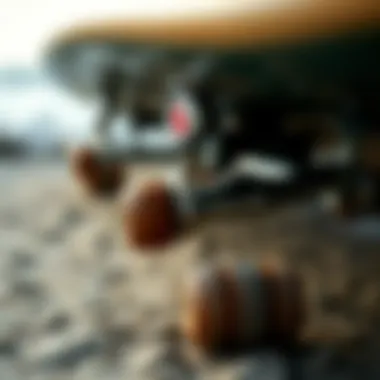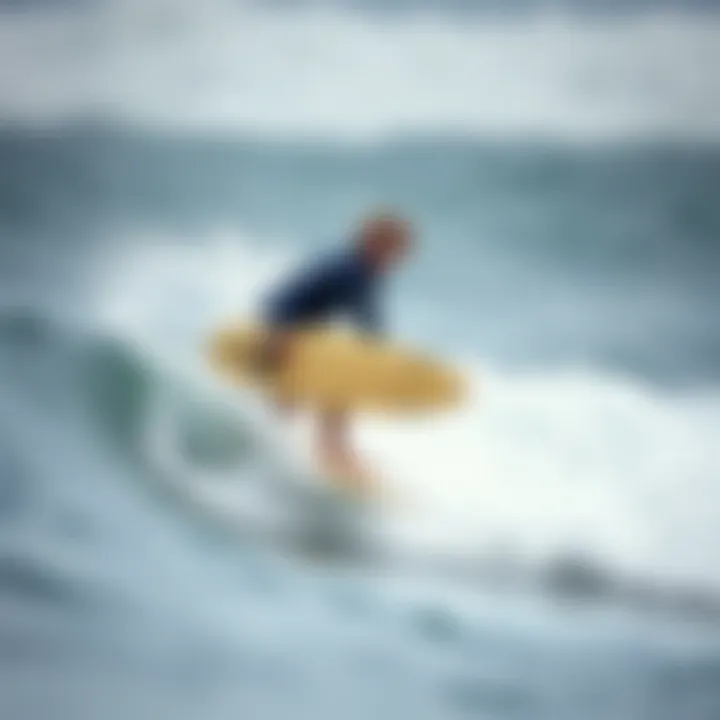A Comprehensive Guide to Longboard Surfing Trucks


Intro
Longboard surfing is more than just a sport; it’s a way of life for many, offering a unique blend of freedom and creativity on the waves. At the heart of this experience are the longboard surfing trucks, crucial components that can make or break a ride. Understanding these trucks, from their design nuances to their functional capabilities, is key to enhancing your performance and enjoyment.
The trucks act as the pivotal connection between your board and the waves. They not only influence stability but also significantly affect how you maneuver your longboard. Choosing the right trucks can feel overwhelming with the numerous options available, especially for those just dipping their toes into the world of longboard surfing.
This article delves deep into the heart of longboard surfing trucks, showcasing their functionality, the variations in design, and how each type impacts the overall surfing experience. By the end of this article, you’ll have the knowledge to make informed decisions tailored to your riding style.
Surfing Techniques
Beginner Tips for Getting Started
Diving into longboard surfing can be daunting, but it's all about finding your balance and learning the ropes. Here’s how to set the groundwork:
- Stance Matters: Your stance on the board influences everything from control to direction. Experiment with regular (left foot forward) and goofy (right foot forward) stances to see what feels natural.
- Start Small: Begin practicing your balance on flat land before hitting the waves. A gentle slope or a calm body of water is ideal for this.
- Paddle Practice: Invest time in mastering the paddling technique—it’s crucial for catching waves and maintaining momentum, especially in bigger waters.
- Foot Placement: As you ride, keep your feet positioned over the trucks for better stability. This simple adjustment can help your balance significantly.
Advanced Maneuvers and Tricks
Once you've got the basics down, it’s time to elevate your skill set. Here are some maneuvers to work towards:
- Carving: This involves turning your board using your body weight and foot placement. Start with gentle turns and gradually increase the sharpness.
- Cutbacks: These are swift turns back towards the breaking wave. They allow you to maintain speed and rhythm while riding.
- Cross-Stepping: A classic longboarding technique where you walk towards the front of the board. This not only looks impressive but also helps you maintain stability.
- Nose Riding: Achieving a strong nose ride requires practice and timing. Approach with confidence, and focus on balance as you shift your weight forward.
"The beauty of longboard surfing lies in its fluid motion and the connection with the ocean. With the right trucks, every wave feels like a dance."
Longboard trucks play a significant role in executing these techniques seamlessly, as they determine the responsiveness of your board on water. Thus, understanding the fit between your chosen trucks and your desired surfing techniques is essential as you journey in this art form.
Understanding Longboard Surfing Trucks
When you think about longboarding, your mind might drift to the smooth, rolling hills and the feel of the wind whizzing past you. But the unsung heroes of this exhilarating experience are, in fact, the longboard trucks. Often overlooked, these components play a pivotal role in shaping your ride. Understanding longboard surfing trucks is crucial for any enthusiast looking to enhance their experience on the waves or pavement. With a proper grasp of their functions, types, and functionalities, you’ll be able to make informed choices that directly affect your stability, maneuverability, and overall performance.
Trucks connect the board to its wheels, serving as the medium through which your actions get translated into motion. Without the right trucks, even the most premium board can feel like a lemon after that summer rain. They affect how your longboard turns, how much grip you get in varied conditions, and even how smooth your ride feels on bumpy sidewalks. It’s not just about bolting on the first truck you see; there are specific elements and benefits tied to each type that you need to consider carefully.
From stability during high-speed rides to smooth sidewalk gliding, understanding these intricate components will usher you into a more enjoyable riding experience. Plus, knowing the differences between various types can save you from hitting the curb too hard!
The Role of Trucks in Longboarding
Trucks are the backbone of your longboard setup. They are like the skeleton that allows the body to move and pivot effectively. When you think of turns, slides, and pivots, it’s these trucks that dictate how smoothly you can execute those maneuvers. A well-designed truck helps absorb shocks from uneven terrain, allowing for a more stable ride even at high speeds. And while your body steers the board, the trucks provide the necessary feedback and responsiveness that makes longboarding enjoyable.
Whether carving through a crowded beach path or riding a steep hill, having the right trucks will help you keep your cool under pressure. They allow you to express your riding style, whether you’re into freestyle longboarding or more traditional surfing techniques.
Types of Longboard Trucks
Longboard trucks come in different flavors, each designed to optimize specific aspects of your ride. They don’t all have the same capabilities—knowing the differences can greatly enhance your longboarding experience.
Traditional Kingpin Trucks
Traditional Kingpin trucks are often the go-to option for many riders. The key characteristic of these trucks is their simple design, which consists of a single kingpin that connects the baseplate to the hanger. Their straightforward mechanism offers a dependable performance that makes them popular among both newbies and seasoned riders.
The major advantage of traditional kingpin trucks is their ease of adjustment. You can fine-tune the tightness of the bushings to change your turning radius, making it easier to achieve your desired feel. However, they may not perform as well during aggressive riding as other types. If you’re taking it easy on your board and favor cruising, these might be the horses for your course.
Drop Through Trucks
Drop Through trucks represent another fabulous choice for riders looking for a lower center of gravity. Their design allows the deck to sit lower relative to the wheels, providing a stable ride that’s especially appreciated when bombing hills or just cruising. The key feature here is the way the board drops through the truck itself, effectively lowering your stance.
This configuration translates into increased stability, which is particularly beneficial for beginners or those who value smooth handling. However, keep in mind that this design limits some performance in terms of sharp turns, making it less suitable for tricks or aggressive riding styles.
Double Kingpin Trucks
Double Kingpin trucks are a standout choice for those looking to push the envelope with their maneuverability. With two kingpins, they allow for a greater range of motion, meaning sharper turns and radical tricks are more achievable. This type is favored by riders focusing on tricks and deeper rail turns, as the responsiveness of these trucks can amplify the riding experience.
Though highly beneficial, they can be a bit tricky to master. The unique design might feel wobbly at first for some riders, so patience is necessary, especially for beginners. Once you nail it, however, you’ll be able to tackle courses and tricks that would have been a handful otherwise.


"The choice of truck can make or break your relationship with your longboard; it's the unsung hero of comfort and control."
Understanding these distinctions between truck types helps guide your decision based on your riding style and preferences. In a sport where every detail counts, knowing which set of trucks complements your board can lead to a ride that is not only pleasant but exhilarating.
Key Components of Longboard Trucks
Understanding the key components of longboard trucks is vital for any surfer who wants to elevate their riding experience. These components, while often overlooked, play a significant role in the performance and handling of a longboard. Without a grasp on these elements, selecting the right trucks can feel like trying to solve a puzzle with missing pieces. The main players in this scenario are the baseplate, hanger, and bushings. Each component contributes uniquely to how a longboard feels underfoot.
Baseplate and Hanger
The baseplate and hanger are the backbone of longboard trucks. The baseplate is the part that secures the truck to the board. It acts almost like a foundation; if it’s solid, the rest flows quite well. Materials like aluminum are common as they provide durability and strength without adding unnecessary weight. A properly designed baseplate can enhance turning capability by allowing optimized pivot points.
On the flip side, the hanger is where the wheels attach and rotate. It determines how smoothly the board glides over surfaces. Think of it this way: a well-functioning hanger will offer good responsiveness as well as the ability to absorb shocks from rough terrain.
In essence, these two parts need to work in harmony. If the baseplate is heavy but the hanger is light, or vice versa, you may get an unbalanced ride. The optimal configuration lies in achieving that sweet spot where both components complement each other.
Bushings and their Importance
Bushings might not be the flashiest part of your longboard trucks, but they are crucial for performance and comfort. These small pieces of rubber act as cushions between the hanger and the baseplate. Their primary job is to absorb the vibrations from the road and offer a smoother ride. Choosing the right bushings can greatly affect how responsive your board feels. They come in different durometers, which means you have options ranging from soft to hard. Softer bushings allow for greater maneuverability and a feeling of surfing on a wave, while harder bushings offer more stability, which is ideal when racing down a hill. Often, beginners might not pay close attention to bushings. But for someone serious about longboarding, they can make a meaningful difference. While they may seem like a minor detail, they significantly influence how a surfer interacts with the board.
"A good truck setup, beginning with its components, is the foundation for mastering your longboarding skills."
To wrap it up, knowing the significance of the baseplate, hanger, and bushings isn't just about technical jargon; it's about enhancing your entire longboarding adventure. Whether you're cruising along the coast or taking sharp turns in a park, understanding these key components can lead to a smoother, more enjoyable journey.
Choosing the Right Longboard Truck
Choosing the right longboard truck is akin to selecting the perfect pair of shoes for a marathon—you want something that fits just right and enhances your performance. Longboard trucks impact not only how you ride but also how you enjoy your time on the waves. It’s crucial to align your selection with your riding style, skill level, and personal preferences. Picking the wrong truck can feel like navigating a ship with a broken rudder, leading to frustration instead of the exhilarating ride you seek.
Factors to Consider
Riding Style
Riding style is the heartbeat of your longboarding experience. Whether you prefer cruising along the beachfront, carving through tight turns, or snagging some tricks, your style nudges you towards specific trucks. A cruiser might find delight in soft bushings with a looser setup, allowing for smooth, flowing maneuvers, while a downhill boarder might opt for a stiffer, more responsive truck to handle the high speeds and aggressive turns. Each style boasts its unique flair and requirements, making it a cornerstone of your choice.
For example, those who enjoy a relaxed, stylish cruising might lean towards traditional kingpin trucks due to their stability and comfort, while tricksters might favour double kingpin trucks for their agility. It's about harmonizing your style with how your truck performs.
Truck Width
The width of the truck plays a pivotal role too. A wider truck generally offers better stability, especially at speed, which is a boon for long-distance cruisers. This specific aspect greatly contributes to how well your board handles in various conditions. A common choice for longboards is the 180mm width, giving a balance of stability without sacrificing turning ability.
A unique feature of wider trucks is their ability to accommodate bigger wheels, which can help in absorbing bumps and providing a smoother ride over uneven surfaces. However, a wider truck can also feel cumbersome for more agile styles, where swift turns are essential. Thus, finding the right balance is important.
Material Composition
The materials used in truck construction also demand consideration. Different materials bring their own personalities into the mix. Aluminum is often the go-to choice due to its lightweight nature and durability, which allows for easy control and performance longevity. However, some may prefer trucks made from steel or other composite materials, particularly for added durability in aggressive riding conditions.
What sets different materials apart is not just weight but how they handle impacts and stress. For instance, while lightweight trucks may facilitate easier maneuvers, they might also wear down quicker. To strike a balance, consider how often you ride and the terrains you typically encounter.
Recommendations by Skill Level
Beginners
For beginners, the best approach is to look for a truck that’s forgiving and easy to handle. Usually, traditional kingpin trucks offer enough stability and maneuverability without overwhelming new riders. The upside of this choice is that it boosts confidence while learning the ropes of balance and navigation. They feature a simple design, making them approachable for those just stepping into the world of longboarding.
However, beginners must also be mindful; a truck that's too flexible can lead to a wobbly ride, causing frustration. It’s essential to strike a balance between comfort and control.
Intermediate Surfers
As an intermediate surfer, your choices can open up considerably. You may want to experiment with different truck types depending on whether you're carving more or starting to dabble in tricks. Trucks that are 180mm wide, perhaps with slightly stiffer bushings, can enhance responsiveness without sacrificing stability. This setup allows for a smoother ride while still enabling you to enjoy a bit of adventure.
A notable feature at this stage is to look for adjustable options, which offer a chance to customize the truck setup as personal style develops. However, this flexibility also requires a willingness to tinker and experiment.
Advanced Riders
For advanced riders, the quest for the perfect truck often involves delving into specialized setups tuned for performance. High-speed stability becomes crucial, pushing many riders toward a double kingpin system. This type grants exceptional agility and allows for tight turns while maintaining stability even at breakneck speeds. The features of these trucks allow experienced surfers to take on aggressive styles with confidence.


On the flip side, they may take some getting used to for riders without experience in their responsiveness. Advanced riders thrive on this challenge but should remain vigilant about the intricacies of each setup.
"Choosing the right longboard truck is key to enhancing not just your performance but your overall enjoyment as you ride. Like picking the right fishing lure, it varies by personal style and conditions of play."
Overall, whether you're just starting, finding your feet in intermediate waters, or carving your path as an advanced rider, understanding these key components will keep your ride smooth and exciting.
Performance Characteristics of Longboard Trucks
In the realm of longboard surfing, the performance characteristics of trucks play a pivotal role in determining how well a rider can engage with the waves. It’s not merely about choosing the right equipment; it’s about understanding how the intricate dynamics of truck design can directly impact one’s surfing experience. The performance features of longboard trucks, such as turn radius and stability, are key elements that enhance both safety and enjoyment while riding.
Key aspects to consider include:
- Turn Radius: This is how sharp or wide a turn your board can make. Longboards tend to favor wider turn radii, but design variations can modify this.
- Maneuverability: It includes how responsive your board feels when turning and adjusting speed, vital for navigating waves effectively.
- Stability: Especially at high speeds, stability ensures that the rider can maintain control while carving or cruising.
For a longboard rider, making sense of these characteristics can be a game-changer and helps in selecting longboard trucks that align with their style and preferences.
Turn Radius and Maneuverability
When it comes to turn radius, understanding the nuances between various truck styles can be enlightening. Trucks designed for tighter turns, such as double kingpin models, offer enhanced maneuverability that is cherished by surfers seeking to navigate through surf with agility. This style lets a rider carve with efficiency, responding quickly to the waves’ rhythm.
The beauty of a well-tuned truck is that it feels intuitive, allowing for graceful turns with effortless motion. Consider this: visualizing the turn radius is like picturing a dancer on stage, seamlessly transitioning between moves, the right trucks will help you to glide through waves like that dancer, embodying grace and precision. To determine how a truck might perform during a turn, it’s essential to take into account its geometry and how bushings respond under pressure.
"Finding the right turn radius feels like discovering the sweet spot in a song – everything just clicks!"
You can also play around with the bushing hardness to get your desired feel. Softer bushings will give a looser feel allowing for tighter turns, while harder bushings lend stability, suited for cruising. In either case, finding your preference can transform your entire surfing experience.
Stability at High Speeds
As speed increases, the dynamics between trucks and boards shift significantly. Stability at high speeds is no small feat; it’s about balance and control. It’s where design elements meet physics. Traditional longboards with wider trucks often provide a stable platform when careening down a slope or navigating bigger waves.
Imagine barreling down a hill on your longboard—if your trucks can't handle that speed, you're in for a wild ride. The right choice of truck ensures not just control, but also instills confidence as you push the limits. Look for wide and heavy-base plates which work hand-in-hand to lower your center of gravity, enhancing that stability.
Another factor that impacts stability is the height of the truck. Low-profile trucks tend to lower the board’s center of gravity, resulting in a more stable ride, whereas taller trucks can provide a greater turning radius but at the cost of stability at speed.
Maintenance and Care for Longboard Trucks
Caring for your longboard trucks is vital—not just for the longevity of the equipment, but also for the performance of your riding experience. Think of your trucks as the unsung heroes of your longboard setup. Without proper maintenance, even the best trucks can fail to deliver the smooth ride you're after. This section will cover key practices for keeping your trucks in tip-top shape, emphasizing how a little diligence can prevent costly repairs down the line.
Regular Inspection Practices
One of the most overlooked aspects of longboard maintenance is the regular inspection of your trucks. Similar to checking the oil in your car or the tread on your tires, it’s crucial to examine your longboard trucks periodically. This simple practice can help catch issues before they escalate.
Here’s what to look for during inspections:
- Tightness of Kingpins: Ensure that the kingpins are securely tightened. Over time, they can loosen, leading to a less responsive ride.
- Bushing Condition: Inspect your bushings for cracks or deformity. Bad bushings can dramatically affect turn responsiveness and comfort.
- Visual Wear: Look for any visible signs of wear or damage to the truck’s baseplate, hanger, and other components. Sometimes a fresh set of bolts or a new paint job can do wonders.
- Regular Cleaning: Dust and dirt can accumulate, which may hinder performance. A quick wipe-down after each session helps in maintaining clean components.
"A stitch in time saves nine." Taking the time to check on your trucks regularly can save you headaches later on.
Adjusting and Replacing Bushings
Bushings may seem like small components compared to the larger parts of your longboard, but don’t underestimate their importance. They provide the cushioning needed for smooth turns and maneuvers. Adjusting and replacing bushings as needed can enhance your ride immensely.
When adjusting bushings, consider:
- Durometer Rating: The hardness or softess of bushings affects your ride. Softer bushings make for easier turns, while harder ones create more stability at higher speeds.
- Height and Shape: Depending on your riding style—freestyle, downhill, or cruising—certain shapes may be better suited.
For replacing bushings, follow these steps:
- Remove the Trucks: Detach your trucks from your longboard for easier access.
- Disassemble: Take off the hanger from the base plate, carefully noting the order of parts.
- Switch the Bushings: Slide out the old ones and replace them with your new selections. Be sure to position them as they were.
- Reassemble and Test: Put everything back together and take a test ride to ensure adjustments are effective.
These practices will not only enable a smoother ride but also prolong the life of your longboard trucks. Adopting a maintenance routine will keep your ride as fresh as a daisy and let you ride the waves worry-free.


Innovations in Longboard Truck Technology
In the realm of longboard surfing, the evolution of technology plays a pivotal role in enhancing performance, safety, and overall surfing experience. As surfers demand more from their gear, innovations in longboard truck technology have been at the forefront of meeting these needs. The incorporation of modern materials, design principles, and adjustable systems not only amplifies user experience but also aligns gear with environmental considerations. This section takes a closer look at these advancements, pinpointing their significance and practical applications.
Materials and Manufacturing Advances
The materials used in constructing longboard trucks significantly influence their durability and performance. Recently, manufacturers have turned to lightweight and robust materials like aluminum alloys and composite plastics. These choices lead to reduced weight without skimping on strength. For instance, aluminum is notable for its excellent strength-to-weight ratio.
- Benefits:
- Weight Reduction: Enhanced maneuverability as trucks feel lighter underfoot.
- Durability: Advanced coatings and alloy treatments protect against corrosion and wear from saltwater exposure.
- Customizability: New materials lend themselves to unique designs, allowing personalization options for aesthetics and function.
With these materials, manufacturers are also integrating modern production techniques, including precision machining and robotics, which allow for tighter tolerances and improved performance consistency across the entire product line. Understanding these advances aids surfers in making informed decisions about which trucks best complement their riding style and preferences.
Adjustable Truck Systems
Adjustable truck systems are a groundbreaking innovation designed to cater to a wide range of riding styles without needing to purchase multiple sets of trucks. These systems allow riders to fine-tune their setup based on the type of terrain or conditions they’re facing.
- Features:
- Easy Adjustment Mechanisms: Many adjustable systems come with simple tools or settings that enable quick tweaks for responsiveness or stability.
- Versatility: Perfectly suited for all types of rides—from cruising to more technical tricks. Surfers can switch between tighter turning radii and more stable configurations depending on their needs.
- Cost-Effectiveness: Rather than purchasing multiple trucks, surfers can maintain one system that adapts to different scenarios.
"The ability to adjust your longboard trucks can truly transform your experience on the water, allowing for a personalized ride that caters to both leisure and performance demands."
The development of adjustable truck systems represents a shift towards customizable equipment in longboard surfing—a crucial factor as more surfers seek equipment that can grow and change with their skills and experiences. Ultimately, by embracing these innovations, surfers can enhance their connection with the waves, making every ride as thrilling as it is refreshing.
Longboard Trucks and Environmental Considerations
Longboard trucks play a significant role not just in how surfers glide on waves, but also in the impact they have on our planet. As surfing continues to grow, so does the need for environmentally conscious decisions in the production of longboard equipment. Understanding how trucks are made and their consequences on ocean ecosystems is crucial for every surfer who cares about maintaining the health of our beaches and waves.
Sustainable Materials in Truck Production
The construction of longboard trucks can often use materials that are not eco-friendly. Traditionally, trucks are made of aluminum, steel, and sometimes plastics that may contribute to pollution if not carefully managed. However, there is a notable shift towards using sustainable materials in truck production.
Some companies now incorporate recycled metals and are exploring bio-based plastics, which are derived from renewable sources. This transition not only reduces reliance on fossil fuels but also lessens the carbon footprint associated with manufacturing. For instance, brands have begun adopting the use of materials like bamboo and composites that break down more easily compared to standard plastics.
When selecting trucks, it’s beneficial for consumers to seek brands that prioritize eco-friendly production. Here are a few considerations:
- Recycled Materials: Look for trucks that certify the use of recycled metals.
- Renewable Resources: Some makers utilize bioplastics which are sourced from plants.
- Low-Impact Manufacturing: Companies that utilize less water and energy in their production processes.
Adopting these sustainable materials not only helps in reducing waste but also reflects a growing ethos within the surfing community that values environmental responsibility.
Impact of Longboard Trucks on Ocean Health
Longboard trucks, while being a small component of the surfing gear, contribute to larger environmental issues, particularly concerning ocean health. Over the years, the accumulation of waste from surfing gear, including broken trucks and other accessories, has begun to raise serious concerns. Improper disposal and the durability of certain plastics can lead to ocean pollution. When trucks break down into smaller bits, they potentially become microplastics, adversely affecting marine life.
Additionally, the chemical processes involved in the production of traditional longboard trucks can release harmful substances into waterways, contributing to pollution. The ongoing use of harmful chemicals during manufacturing can have far-reaching consequences for marine habitats.
Surfers and manufacturers must be conscious of the lifecycle of these products. Some initiatives include:
- Environmental Sponsorships: Collaborations with organizations focused on ocean preservation, ensuring a part of profits is allocated to ocean cleaning initiatives.
- Awareness Campaigns: Educating surfers about the importance of responsible disposal and recycling of surfing products.
- Innovative Recycling Programs: Programs that allow users to send back old trucks for proper recycling.
“By embracing sustainability, surfers can help keep our oceans pristine for generations to come.”
For more details about sustainable surfing practices, you can check out websites like Surfrider Foundation or scholarly articles on platforms such as ResearchGate.
Overall, understanding and addressing the environmental impact of longboard trucks prepares us for a future that honors both our passion for surfing and our responsibility to protect the oceans.
Culmination
In the world of longboarding, the trucks are often overlooked while discussing gear. However, as we've explored, they play a crucial role in shaping the riding experience. Understanding the nuances of longboard trucks can significantly affect ride quality, stability, and performance. Choosing the right trucks not only enhances maneuverability but also ensures safety and comfort on the waves.
Summarizing Key Points on Longboard Trucks
- The Role of Trucks in Longboarding: Trucks serve as the fundamental link between the longboard deck and the wheels. Their design affects how surfers turn, steer, and respond to the terrain beneath them.
- Types of Longboard Trucks: Knowing the different types—Traditional Kingpin, Drop Through, and Double Kingpin—enables surfers to tailor their setup to their specific riding style. Each type offers unique advantages, catering to distractions from cruising on smooth pavement to tackling rough terrains.
- Performance Characteristics: Factors like turn radius and stability impact how well a rider can control their board at various speeds. The right choice in trucks can elevate a riding experience, cementing a connection between the surfer and the waves.
- Innovations in Truck Technology: The landscape of longboard technology is ever-evolving. New materials and adjustable systems are being developed, offering surfers ways to fine-tune their boards to match their preferences.
- Environmental Considerations: With the growing awareness of ecological impact, opting for sustainable materials in truck production becomes not only a personal choice but also a step towards protecting ocean health.
By keeping these key points in mind, surfers can make more informed decisions when selecting their longboard trucks, thus enhancing their overall surfing experience. For any longboarder, from the weekend warrior to the seasoned pro, understanding these aspects elevates one’s approach to the sport. It's not just about catching waves; it's about how the equipment complements the rider’s journey, making every moment spent on the board more enjoyable.



